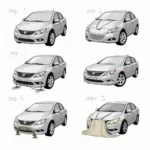Car seat stitching is prone to wear and tear over time, especially with frequent use. A torn or frayed seam not only impacts the aesthetics of your car’s interior but can also compromise the structural integrity of the seat itself. Thankfully, repairing car seat stitching is often a manageable DIY project that can save you a trip to the upholstery shop. This comprehensive guide will equip you with the knowledge and steps to effectively repair your car seat stitching and restore your car’s interior to its former glory.
Assessing the Damage: Knowing Your Repair Options
Before diving into the repair, it’s crucial to assess the extent of the damage. This evaluation will determine the appropriate repair method and the materials you’ll need. Here’s a breakdown:
- Minor Fraying or Loose Threads: This type of damage is usually addressed with simple thread trimming and securing.
- Seam Separation: When the stitching comes undone, resulting in a gap, you’ll need to restitch the seam.
- Rips or Tears in the Seat Material: These require patching or more advanced repair techniques, often best left to professional upholsterers.
Gathering Your Tools and Materials
Once you’ve assessed the damage, gather the necessary tools and materials. For most basic car seat stitching repairs, you will need:
- Heavy-duty Upholstery Thread: Choose a thread that closely matches the color of your car’s upholstery for a seamless repair.
- Curved Upholstery Needle: The curved needle is designed for sewing through thick materials and curved surfaces, making it ideal for car seats.
- Sharp Scissors: For trimming threads and any excess fabric.
- Seam Ripper: This tool helps remove any old or damaged stitching.
- Fabric Glue (Optional): For securing loose fabric edges before stitching.
- Leather Filler (Optional): Used to fill in small cracks or holes in leather seats before stitching.
- Leather Adhesive (Optional): For bonding leather patches or reinforcing repairs.
Step-by-Step Guide to Repairing Car Seat Stitching
For this guide, we’ll focus on repairing a separated seam, a common car seat stitching issue.
Step 1: Preparation is Key
- Begin by parking your car in a well-lit area.
- Move the seat to a position that provides easy access to the damaged area.
- Use a vacuum cleaner or brush to remove any dirt, dust, or debris from the seat.
Step 2: Removing Old Stitching
- Carefully insert the point of your seam ripper under the stitches you want to remove.
- Gently lift the seam ripper to cut the threads.
- Repeat this process along the entire length of the damaged seam.
Step 3: Threading the Needle and Securing the Thread
- Cut a length of upholstery thread approximately 18-24 inches long.
- Thread the needle, ensuring you have a comfortable length for sewing.
- Tie a knot at the end of the thread to secure it.
Step 4: Restitching the Seam
- Starting from the inside of the seam, insert the needle through the existing stitch hole on one side of the fabric.
- Pull the thread through until the knot rests against the fabric.
- Insert the needle directly across from the first stitch hole, going through to the other side.
- Pull the thread taut, ensuring a tight and even stitch.
- Repeat this process, following the original stitch line as closely as possible.
- For a stronger repair, consider using a backstitch every few stitches. To backstitch, simply insert the needle back through the previous stitch hole before moving forward.
Step 5: Knotting and Securing the End
- Once you’ve reached the end of the seam, tie a secure knot on the underside of the fabric to prevent the stitching from unraveling.
- Trim any excess thread.
Expert Insights: Professional Tips for Best Results
“When choosing your upholstery thread, opt for a slightly thicker thread than the original. This will enhance the strength and durability of your repair,” says Sarah Jones, a seasoned automotive upholsterer with over 20 years of experience. “Also, don’t be afraid to practice your stitching technique on a scrap piece of fabric before working on your car seat. This will help you get a feel for the needle and thread, ensuring a neater and more professional-looking repair.”
Maintaining Your Repaired Car Seat Stitching
Once you’ve successfully repaired your car seat stitching, it’s essential to take preventative measures to avoid future damage and keep your upholstery looking its best.
- Regular Cleaning: Regularly vacuum or brush your car seats to remove dirt and debris that can cause abrasion.
- Use Seat Covers: Consider using seat covers, especially if you frequently transport children or pets.
- Avoid Sharp Objects: Be mindful of sharp objects that could potentially puncture or tear your car seats.
Conclusion: Restore Your Car’s Interior with Confidence
Repairing car seat stitching is a rewarding DIY project that can breathe new life into your car’s interior. By following these step-by-step instructions and expert tips, you can achieve professional-looking results and prolong the lifespan of your car seats. Remember to carefully assess the damage, use the right tools and materials, and practice patience for a successful repair.


